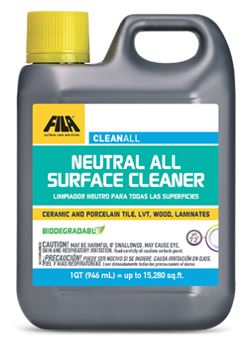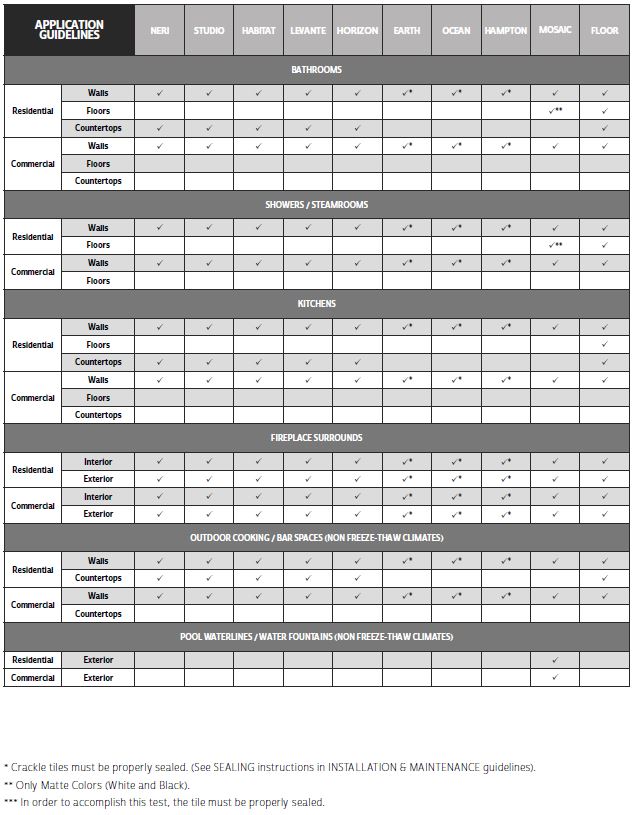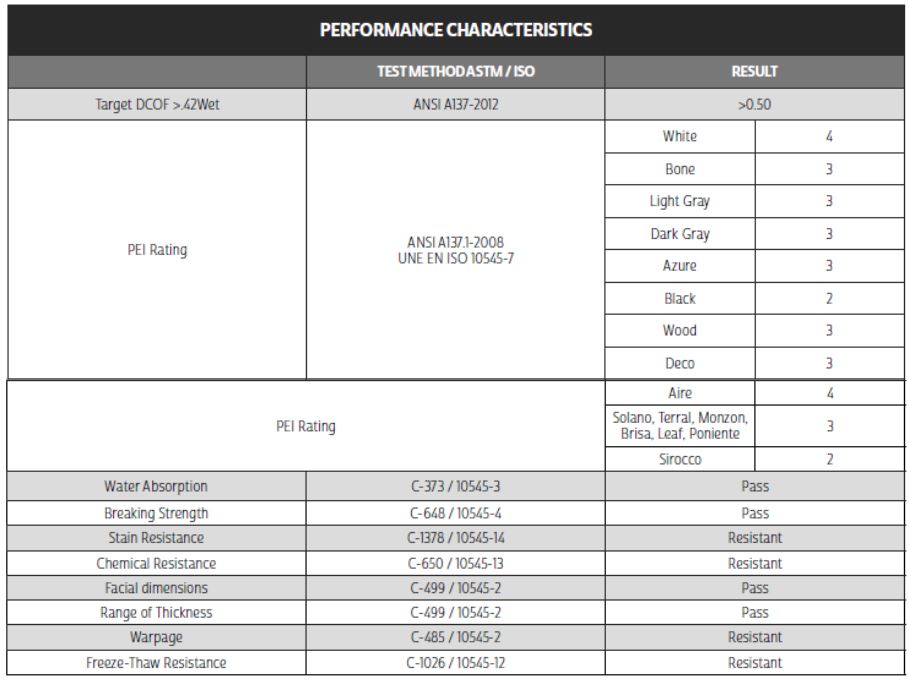INSTALLATION AND MAINTENANCE
Ceramic & Porcelain Tiles
INSTALLATION
CERAMIC TILES
The surface where the product is going to be installed must be clean and level.
We strongly recommend dry laying prior to installation. Blending of the ceramic tile glaze is key to insuring a pleasing overall look to your room. This will resolve any color or size issues prior to installation and will serve as a review of tile placement.
All our tiles are to be installed using the prevailing guidelines as set forth in the TCNA (Tile Council of North America) Handbook and the ANSI (American National Standards Institute) specifications. Installation should be carried out by experienced personnel.

SETTING MATERIALS
Install with any high-quality adhesive recommended for ceramic tiles. This must also be suitable for the environment they will have to withstand.
Fitting with traditional mortars does not ensure good adhesion.
For Mud Installations, all setting materials and installation methods should be performed using the prevailing guidelines set by the TCNA (Tile Council of North America) Handbook and the ANSI (American National Standards Institute) specifications.
GROUT
UNSANDED grout is typically used for grout joints 1/8” or smaller.
SANDED grout is recommended for grout joints larger than 1/8”, as long as the excess material is removed with a damp sponge. Using notched trowels or grout floats may scratch the tile. Special care should be exercised with high sheen surfaces.
The color of the grout should be as close as possible to the color of your tile.
WE DO NOT RECOMMEND CONTRASTING COLOR GROUTS ON OUR CRACKLED GLAZED TILES.
NOTE: For Satin Finish tiles, due to the nature of some dark grout pigments, it is recommended to avoid dark color or contrasting color grout, to prevent potential staining and grout haze.
METHOD
Follow the appropriate standard ceramic procedures provided by the TCNA (Tile Council of North America) Handbook and the ANSI (American National Standards
Institute) specifications.
The surfaces of raised/dimensional decorative accents, borders or liners can be taped off during grouting to facilitate cleanup. To help keep border, liner and molding grout joints tight, offset the joints between field tile, trim and accent rows.
SEALING
Solid Glazes:
Sealing is not required for Solid Glazes.
Crackle Glazes:
The effect of crackle glaze on ceramic tile occurs when the glaze and the body of the tile undergo differential shrinkage and cooling.
This process leads to surface tension and the formation of cracks.
Varying levels of contraction in the glaze and clay creates delicate micro-fractures within the glaze.
SEALING IS MANDATORY FOR CRACKLE GLAZES. WE RECOMMEND SEALING OUR CRACKLED GLAZE TILES WITH A SOLVENT BASED PENETRATING SEALER BEFORE AND AFTER GROUTING.
1. The sealer penetrates the fine, hairline fissures in the glaze and prevents dirt and dusk darkening the crackle over a period of time.
2. Sealing the crackled glaze makes it easier to maintain and clean.
3. Proper application of the sealer (wipe off any excess from glazed surface) will not harm or change the appearance of the tile.
4. Reapply to grout joints and crackle glazes periodically as needed. When water no longer beads on the surface of the joints, resealing is required.
We recommend the following products and procedures:
Once the tile is mounted on the wall and before grouting, the tile surface must be clean and free of dirt and dust. Use the FILA MP90 - Natural Look Penetrating Sealer (Available in our Price List) which is a solvent based sealer. Apply an even coat of FILAMP90 with a paintbrush or lambswool applicator pad. Wait 24 Hours to allow the product to cure. Apply grout with a sponge evenly distributing grout over joints. Do not use a grout float.
Once the grouting is completed and allowed to dry, the surface of the tiles must be cleaned using FILA CLEANER - Neutral Cleaner (Available in our Price List) observing the following guidelines: Dilute to 1:30. Clean the surface with a cloth and scrubbing brush. Remove any residue and rinse thoroughly.
After the thorough cleaning of the surface and grout residue, the tile will need to be resealed using the FILA MP90 - Natural Look Penetrating Sealer (Available in our Price List) observing the following guidelines: Apply an even coat of FILAMP90 with a paintbrush or lambswool applicator pad. Wipe off product excess after 15 minutes, making sure to rub the product and help its complete penetration into the material. Wait 24 Hours to allow the product to cure.
NOTE: Future Sealing of the product should be done if you see any discoloration/darkening in the body of the tile. This will vary by end usage, care and maintenance products and tools used.
If you use any other sealer, please check with the manufacturer for the proper instructions and products to use for sealing crackled glaze ceramic tile.
MAINTENANCE
Clean the tiles regularly with a nonabrasive/non-acidic, mild and PH neutral cleaner.
We recommend FILA CLEANER – Neutral Cleaner (Available in our Price List) for all cleaning purposes of our tile. Sealer: Reapply to grout joints and crackle glazes periodically as needed. When water no longer beads on the surface of the joints, resealing is required.
HABITAT GLOSSY TILES: INSTALLATION GUIDELINES
ADEX USA tiles are to be installed using the prevailing guidelines as set forth in the TCNA (Tile Council of North America) Handbook and the ANSI (American National Standards Institute) specifications. Installation should be carried out by experienced personnel.
• The surface where the product is going to be installed must be clean and level.
• Dry Layout: Habitat is a multi-tone glaze. We strongly recommend dry laying prior to installation. Blending of the ceramic tile glaze is key to ensuring a pleasing overall look to your room. This will resolve any color or size issues prior to installation and will serve as a review of tile placement.
• Setting bed preparation: For best results, ensure the flatness of the surface is within 1/8” tolerance in 10 linear feet.
• Mortar Thickness: An even setting bed of mortar no greater than 1/4” thick should be used for best results.
• Recommended setting materials: For best results use Rapid set mortars such as Custom Building Products ProLite® Rapid Setting Tile & Stone Mortar; or Custom Building Products ProLite® Tile & Stone Mortar. When installing Habitat over impervious membranes, use an epoxy adhesive such as Custom Building Products -EBMLite™ Epoxy Bonding Mortar or CEG-Lite™ 100% Solids Commercial Epoxy Grout and Mortar.
• Expansion Joints: Strict adherence to the TCNA EJ171 standard is mandatory.
• Grout Joints: Spacers should be used for even grout joints. 1/8” grout joints are recommended.
• Grout recommendations: Unsanded grout is typically used for grout joints 1/8” or smaller. Sanded grout is recommended for grout joints larger than 1/8”, as long as the excess material is removed with a damp sponge. Using notched trowels or grout floats may scratch the tile. Special care should be exercised with high sheen surfaces to avoid scratches.
GLAZED PORCELAIN TILES
Install with any high-quality adhesive recommended for porcelain tiles. This must also be suitable for the environment they will have to withstand. Fitting with traditional mortars does not ensure good adhesion.
For Mud Installations, all setting materials and installation methods should be performed using the prevailing guidelines set by the TCNA (Tile Council of North America) Handbook and the ANSI (American National Standards Institute) Specifications.
GROUT
For Porcelain tiles, we recommend using a minimum of 5/64-inch (0.08” or 2mm) spacers for a perfect alignment of the tiles. It will also be necessary to make small adjustments by hand to compensate for the natural dimensional variations of the tiles. The joints should be filled in with appropriate materials according to the specifications given by the joint filling material manufacturer. We do not recommend the installation of porcelain tiles without joints.
METHOD
Follow the appropriate standard ceramic, porcelain and glass tile installation procedures provided by the TCNA (Tile Council of North America) Handbook and
the ANSI (American National Standards Institute) specifications.
MAINTENANCE
Clean the tile regularly with a non-abrasive/non-acidic, mild and PH neutral cleaner.
We recommend FILA CLEANER – Neutral Cleaner (Available in our Price List) for all cleaning purposes of our tile.
Use products which are suitable to eliminate the remains of mortar, cement, etc. Never use an acidic cleaning agent on newly installed flooring because the acid reacts
with the unset cement and can damage the seals, or insoluble compounds can be deposited on the surface of the paving.
Do not use metal scrapers or abrasive pads.
Daily cleaning, after use, will be made particularly easy as it only requires clean water and a very well-wrung cloth. In areas where the tile could be especially messy (kitchens), a detergent with bleach or ammonia can be added to water, although in this case we always recommend giving a final rinse with clear water. Do not use waxes, oils or similar products. In some cases, we can find ourselves in the situation of having to clean very dry and specific stains, which cannot be removed with a damp cloth, but that will disappear if we apply concentrated bleach (the one for floors, not the one used for clothes) and leave it to dry. For especially resistant stains it may be necessary to repeat the process.
For floor surfaces; water, grease, oil, etc. create slippery conditions. Floor applications with exposure to these conditions require extra caution in product selection and maintenance.
SEALING
Sealing is not required for Solid Glazes.
Sealing is mandatory for Crackle Glazes. We recommend to seal our tiles with a penetrating sealer before and after grouting.
The effect of crackle glaze on ceramic tile occurs when the glaze and the body of the tile undergo differential shrinkage and cooling. This process leads to surface tension and the formation of cracks. Varying levels of contraction in the glaze and clay creates delicate micro-fractures within the glaze.
- The sealer penetrates the fine, hairline fissures in the glaze and prevents dirt and dusk darkening the crackle over a period of time.
- Sealing the crackled glaze makes it easier to maintain and clean.
- Proper application of the sealer (wipe off any excess from glazed surface) will not harm or change the appearance of the tile.
- Reapply to grout joints and crackle glazes periodically as needed. When water no longer beads on the surface of the joints, resealing is required.

We recommend the following products and procedures:
Once the tile is mounted on the wall and before grouting, the tile surface must be clean and free of dirt and dust. Use the FILAMP90 – Natural Look Penetrating Sealer (available from your ADEX USA DEALERS) which is a solvent based sealer. Apply an even coat of FILAMP90 with a paintbrush or lambs wool applicator pad. Wait 24 Hours to allow the product to cure. Apply grout with a sponge evenly distributing grout over joints. Do not use a grout float.
NOTE: Although not recommended, if you choose to use Contrasting Color Grouts, it is imperative that the tiles are thoroughly sealed to avoid the discoloration from the grout pigment. Please follow the mixing grouting instructions of the Grout Manufacturer.
Once the grouting is completed and allowed to dry, the surface of the tiles must be cleaned using FILA CLEANER – Neutral Cleaner (available from your ADEX USA DEALERS): Dilute to 1:30. Clean the surface with a cloth and scrubbing brush. Remove any residue and rinse thoroughly.
After the thorough cleaning of the surface and grout residue, the tile will need to be resealed using the FILAMP90 – Natural Look Penetrating Sealer (available from your ADEX USA DEALERS) observing the following guidelines: Apply an even coat of FILAMP90 with a paintbrush or lambs wool applicator pad. Wipe off product excess after 15 minutes, making sure to rub the product and help its complete penetration into the material. Wait 24 Hours to allow the product to cure.
NOTE: Future Sealing of the product should be done if you see any discoloration/darkening in the body of the tile. This will vary by end usage, care and maintenance products and tools used.
If you use any other sealer, please check with the manufacturer for the proper instructions and products to use for sealing crackled glaze ceramic tile.
MAINTENANCE
CERAMIC TILES
Clean the tiles regularly with a non-abrasive/non-acidic, mild and PH neutral cleaner.
We recommend FILA CLEANER – Neutral Cleaner (available in our Price List) for all cleaning purposes of our tile.
Reapply sealer to grout joints and crackle glazes periodically as needed. When water no longer beads on the surface of the joints, resealing is required.
GLAZED PORCELAIN TILES
Clean the tile regularly with a non-abrasive/non-acidic, mild and PH neutral cleaner.
We recommend FILA CLEANER – Neutral Cleaner (Available in our Price List) for all cleaning purposes of our tile.
Use products which are suitable to eliminate the remains of mortar, cement, etc. Never use an acidic cleaning agent on newly installed flooring because the acid reacts with the unset cement and can damage the seals, or insoluble compounds can be deposited on the surface of the paving.
Do not use metal scrapers or abrasive pads.
Daily cleaning, after use, will be made particularly easy as it only requires clean water and a very well-wrung cloth. In areas where the tile could be especially messy (kitchens), a detergent with bleach or ammonia can be added to water, although in this case we always recommend giving a final rinse with clear water. Do not use waxes, oils or similar products. In some cases, we can find ourselves in the situation of having to clean very dry and specific stains, which cannot be removed with a damp cloth, but that will disappear if we apply concentrated bleach (the one for floors, not the one used for clothes) and leave it to dry. For especially resistant stains it may be necessary to repeat the process.
For floor surfaces; water, grease, oil, etc. create slippery conditions. Floor applications with exposure to these
conditions require extra caution in product selection and maintenance.

PLEASE NOTE
Due to the nature of our tile, a certain amount of variation in color, shading, surface and texture are to be expected.
Use of the tile constitutes acceptance. We assume no responsibility for installation.
The installation information provided is to be used as a guideline only and should be discussed with a professional and accredited tile installer.



